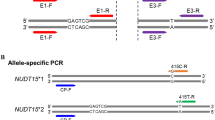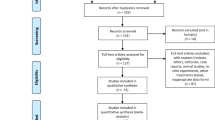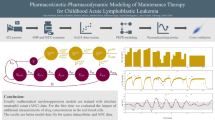Abstract
Background
Mercaptopurine-induced neutropenia can interrupt chemotherapy and expose patients to infection during childhood acute lymphoblastic leukemia (ALL) treatment. Previously, six candidate gene variants associated with mercaptopurine intolerance were reported. Herein, we investigated the association between the mean tolerable dose of mercaptopurine and these genetic variants in Taiwanese patients.
Methods
In total, 294 children with ALL were treated at the National Taiwan University Hospital from April 1997 to December 2017. Germline variants were analyzed for NUDT15, SUCLA2, TPMT, ITPA, PACSIN2, and MRP4. Mean daily tolerable doses of mercaptopurine in the continuation phase of treatment were correlated with these genetic variants.
Results
Mercaptopurine intolerance was significantly associated with polymorphisms in NUDT15 (P value < 0.0001). Patients with SUCLA2 variants received lower mercaptopurine doses (P value = 0.0119). The mean mercaptopurine doses did not differ among patients with TPMT, ITPA, MRP4, and PACSIN2 polymorphisms (P value = 0.9461, 0.5818, and 0.7951, respectively). After multivariable linear regression analysis, only NUDT15 variants retained their clinically significant correlation with mercaptopurine intolerance (P value < 0.0001).
Conclusion
In this cohort, the major genetic determinant of mercaptopurine intolerance was NUDT15 in Taiwanese patients.
Impact
-
NUDT15 causes mercaptopurine intolerance in children with ALL.
-
The NUDT15 variant is a stronger predictor of mercaptopurine intolerance than TPMT in a Taiwanese cohort. This finding is similar with studies performed on Asian populations rather than Caucasians.
-
Pre-emptive genotyping of the patients’ NUDT15 before administering mercaptopurine may be more helpful than genotyping TPMT in Asians.
Similar content being viewed by others
Log in or create a free account to read this content
Gain free access to this article, as well as selected content from this journal and more on nature.com
or
References
Relling, M. V. et al. Clinical pharmacogenetics implementation consortium guideline for thiopurine dosing based on TPMT and NUDT15 genotypes: 2018 update. Clin. Pharmacol. Ther. 105, 1095–1105 (2019).
Sutiman, N. et al. Predictive role of NUDT15 variants on thiopurine-induced myelotoxicity in Asian inflammatory bowel disease patients. Pharmacogenom. J. 19, 31–43 (2018).
Gerbek, T. et al. Role of TPMT and ITPA variants in mercaptopurine disposition. Cancer Chemother. Pharmacol. 81, 579–586 (2018).
Tanaka, Y. et al. Interaction between NUDT15 and ABCC4 variants enhances intolerability of 6-mercaptopurine in Japanese patients with childhood acute lymphoblastic leukemia. Pharmacogenom. J. 18, 275–280 (2018).
Liu, C. et al. Differential effects of thiopurine methyltransferase (TPMT) and multidrug resistance-associated protein gene 4 (MRP4) on mercaptopurine toxicity. Cancer Chemother. Pharmacol. 80, 287–293 (2017).
Choi, R. et al. Pathway genes and metabolites in thiopurine therapy in Korean children with acute lymphoblastic leukaemia. Br. J. Clin. Pharmacol. 85, 1585–1597 (2019).
Zhou, H. et al. Optimal predictor for 6-mercaptopurine intolerance in Chinese children with acute lymphoblastic leukemia: NUDT15, TPMT, or ITPA genetic variants? BMC Cancer 18, 516 (2018).
Yang, S. K. et al. common missense variant in NUDT15 confers susceptibility to thiopurine-induced leukopenia. Nat. Genet. 46, 1017–1020 (2014).
Moriyama, T. et al. NUDT15 polymorphisms alter thiopurine metabolism and hematopoietic toxicity. Nat. Genet. 48, 367–373 (2016).
Moriyama, T. et al. Novel variants in NUDT15 and thiopurine intolerance in children with acute lymphoblastic leukemia from diverse ancestry. Blood 130, 1209–1212 (2017).
Lee, S. H. R. & Yang, J. J. Pharmacogenomics in acute lymphoblastic leukemia. Best. Pract. Res. Clin. Haematol. 30, 229–236 (2017).
Liang, D. C. Unexpected mortality from the use of E. coli l-asparaginase during remission induction therapy for childhood acute lymphoblastic leukemia: a report from the Taiwan Pediatric Oncology Group. Leukemia 13, 155–160 (1999).
Lin, W. Y., Liu, H. C., Yeh, T. C., Wang, L. Y. & Liang, D. C. Triple intrathecal therapy without cranial irradiation for central nervous system preventive therapy in childhood acute lymphoblastic leukemia. Pediatr. Blood Cancer 50, 523–527 (2008).
Li, M. J. et al. Treatment for childhood acute lymphoblastic leukemia in Taiwan: Taiwan Pediatric Oncology Group ALL-2002 study emphasizing optimal reinduction therapy and central nervous system preventive therapy without cranial radiation. Pediatr. Blood Cancer 64, 234–241 (2017).
Liang, D. C. et al. Long-term results of Taiwan Pediatric Oncology Group studies 1997 and 2002 for childhood acute lymphoblastic leukemia. Leukemia 24, 397–405 (2010).
Yang, J. J. et al. Pharmacogene Variation Consortium Gene Introduction: NUDT15. Clin. Pharmacol. Ther. 105, 1091–1094 (2019).
Liang, D. C. et al. NUDT15 gene polymorphism related to mercaptopurine intolerance in Taiwan Chinese children with acute lymphoblastic leukemia. Pharmacogenom. J. 16, 536–539 (2016).
Chiengthong, K. et al. NUDT15 c.415C>T increases risk of 6-mercaptopurine induced myelosuppression during maintenance therapy in children with acute lymphoblastic leukemia. Haematologica 101, e24–e26 (2016).
Buaboonnam. J. et al. Effect of NUDT15 on incidence of neutropenia in children with acute lymphoblastic leukemia. Pediatr. Int. 61, 754–758 (2019).
Zgheib, N. K. et al. NUDT15 and TPMT genetic polymorphisms are related to 6-mercaptopurine intolerance in children treated for acute lymphoblastic leukemia at the Children’s Cancer Center of Lebanon. Pediatr. Blood Cancer 64, 146–150 (2017).
Tanaka. Y. et al. Susceptibility to 6-MP toxicity conferred by a NUDT15 variant in Japanese children with acute lymphoblastic leukaemia. Br. J. Haematol. 171, 109–115 (2015).
Suzuki, H. et al. Genotyping NUDT15 can predict the dose reduction of 6-MP for children with acute lymphoblastic leukemia especially at a preschool age. J. Hum. Genet. 61, 797–801 (2016).
Park, Y. et al. Star allele-based haplotyping versus gene-wise variant burden scoring for predicting 6-mercaptopurine intolerance in pediatric acute lymphoblastic leukemia patients. Front. Pharmacol. 10, 654 (2019).
Yang, J. J. et al. Inherited NUDT15 variant is a genetic determinant of mercaptopurine intolerance in children with acute lymphoblastic leukemia. J. Clin. Oncol. 33, 1235–1242 (2015).
Schaeffeler, E. et al. Impact of NUDT15 genetics on severe thiopurine-related hematotoxicity in patients with European ancestry. Genet. Med. 21, 2145–2150 (2019).
Zhu, Y. et al. Combination of common and novel rare NUDT15 variants improves predictive sensitivity of thiopurine-induced leukopenia in children with acute lymphoblastic leukemia. Haematologica 103, e293–e295 (2018).
Kim, J. H. et al. Influences of thiopurine methyltransferase genotype and activity on thiopurine-induced leukopenia in Korean patients with inflammatory bowel disease: a retrospective cohort study. J. Clin. Gastroenterol. 44, e242–e248 (2010).
Park, S. K. et al. Influences of XDH genotype by gene-gene interactions with SUCLA2 for thiopurine-induced leukopenia in Korean patients with Crohn’s disease. Scand. J. Gastroenterol. 51, 684–691 (2016).
Tanaka, Y. et al. The activity of the inosine triphosphate pyrophosphatase affects toxicity of 6-mercaptopurine during maintenance therapy for acute lymphoblastic leukemia in Japanese children. Leuk. Res. 36, 560–564 (2012).
Wan Rosalina, W. R. et al. Polymorphism of ITPA 94C>A and risk of adverse effects among patients with acute lymphoblastic leukaemia treated with 6-mercaptopurine. J. Clin. Pharm. Ther. 37, 237–241 (2012).
Farfan, M. J. et al. Prevalence of TPMT and ITPA gene polymorphisms and effect on mercaptopurine dosage in Chilean children with acute lymphoblastic leukemia. BMC Cancer 14, 299 (2014).
Khera, S. et al. Prevalence of TPMT, ITPA and NUDT 15 genetic polymorphisms and their relation to 6MP toxicity in north Indian children with acute lymphoblastic leukemia. Cancer Chemother. Pharmacol. 83, 341–348 (2019).
Moradveisi, B. et al. ITPA, TPMT, and NUDT15 genetic polymorphisms predict 6-mercaptopurine toxicity in Middle Eastern children with acute lymphoblastic leukemia. Front. Pharm. 10, 916 (2019).
Ma, X. et al. Inosine triphosphate pyrophosphohydrolase (ITPA) polymorphic sequence variants in Chinese ALL children and possible association with mercaptopurine related toxicity. Int. J. Clin. Exp. Pathol. 7, 4552–4556 (2014).
Tanaka, Y. et al. Multidrug resistance protein 4 (MRP4) polymorphisms impact the 6-mercaptopurine dose tolerance during maintenance therapy in Japanese childhood acute lymphoblastic leukemia. Pharmacogenom. J. 15, 380–384 (2015).
Stocco, G. et al. PACSIN2 polymorphism influences TPMT activity and mercaptopurine-related gastrointestinal toxicity. Hum. Mol. Genet 21, 4793–4804 (2012).
Smid, A. et al. PACSIN2 polymorphism is associated with thiopurine-induced hematological toxicity in children with acute lymphoblastic leukaemia undergoing maintenance therapy. Sci. Rep. 6, 30244 (2016).
Acknowledgements
We thank all the patients who participated in this study and their parents. We also acknowledge TPOG and the Childhood Cancer Foundation in Taiwan for their assistance in data collection and management. This work was supported by the Ministry of Science and Technology (No. 106-2314-B-002-199-) and the National Taiwan University Hospital (107-S3890). We gratefully acknowledge the financial support of the National Science Council of Taiwan, ROC.
Author information
Authors and Affiliations
Contributions
D.-S.W.: writing—original draft preparation, visualization, investigation, and data curation. C.-H.Y.: writing—original draft preparation, investigation, and data curation. Y.-H.C.: formal analysis, investigation, and data curation. C.-Y.L.: formal analysis. K.-H.L.: resources. S.-T.J.: resources. M.-Y.L.: resources. H.-H.C.: resources. S.-W.L.: supervision, writing—review and editing. D.-T.L.: Resources. H.-Y.C.: methodology, formal analysis. Y.-L.Y.: project administration, supervision, writing—review and editing, resources, conceptualization.
Corresponding author
Ethics declarations
Competing interests
The authors declare no competing interests.
Informed consent
Informed consent was obtained from the parents or legal guardians of the patients, and, in total, 294 patients were enrolled at the study’s initiation.
Additional information
Publisher’s note Springer Nature remains neutral with regard to jurisdictional claims in published maps and institutional affiliations.
Rights and permissions
About this article
Cite this article
Wang, DS., Yu, CH., Lin, CY. et al. Childhood acute lymphoblastic leukemia mercaptopurine intolerance is associated with NUDT15 variants. Pediatr Res 89, 217–222 (2021). https://doi.org/10.1038/s41390-020-0868-8
Received:
Revised:
Accepted:
Published:
Issue date:
DOI: https://doi.org/10.1038/s41390-020-0868-8
This article is cited by
-
Evaluation of FTO polymorphism in 6-mercaptopurine related intolerance in children with acute lymphoblastic leukemia
Cancer Chemotherapy and Pharmacology (2023)
-
Allele-specific polymerase chain reaction can determine the diplotype of NUDT15 variants in patients with childhood acute lymphoblastic Leukemia
Scientific Reports (2023)
-
Association of genetic variants in TPMT, ITPA, and NUDT15 with azathioprine-induced myelosuppression in southwest china patients with autoimmune hepatitis
Scientific Reports (2021)
-
Determination of NUDT15 variants by targeted sequencing can identify compound heterozygosity in pediatric acute lymphoblastic leukemia patients
Scientific Reports (2020)



